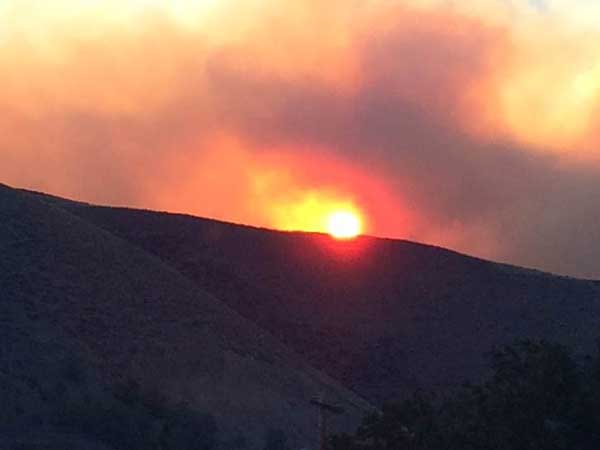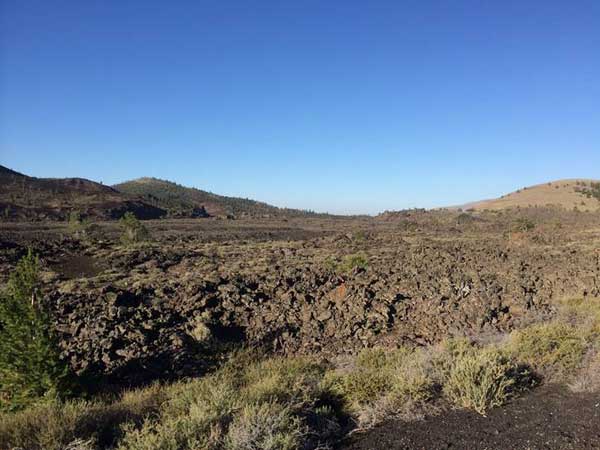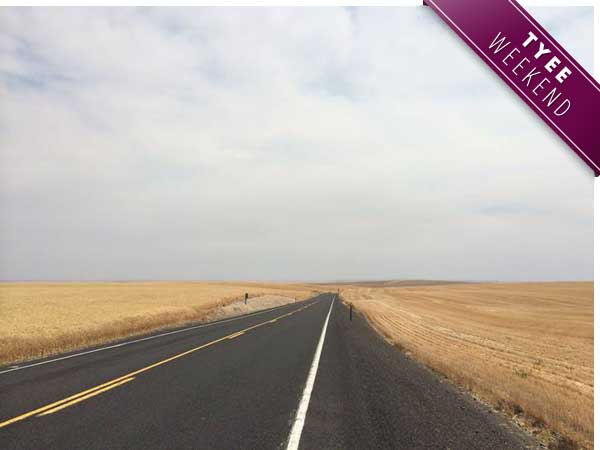There comes a point -- somewhere on a winding stretch of road, maybe hemmed by trees on one side and a cascading river on the other -- when you feel like you are floating, almost flying, and the wind stops battering you about the head and torso and starts to wash over and envelop you in a sort of existential massage.
If you are lucky, you find a place, a mere pocket of time when you lean into and out of every curve like a snowboarder, a glorious conspiracy of torque, tarmac and tension that feeds a conceit that you have limitless momentum, that the highway was built just for you and it will feed you forever.
And then you snap out of your reverie.
It could be a truck blast that almost knocks you off the road; a deer that's chosen to graze on asphalt as you round a corner at speed; another bike that overtakes you by surprise; a rock fall or a series of potholes that forces you to slow down; the fuel warning light coming on sooner than you'd bargained for.
Suddenly, you are simply riding again, putting in time in the saddle but knowing that the altered state will return someplace down the track, if not again today, for sure tomorrow.
But when that symbiosis happens -- that meeting of man, motor and macadam that feels more like aviation than mere ambulation -- well, it's hard not to feel that you didn't just discover something so much as invented it.
Ah, the glorious and contradictory thing that is the motorcycle.
It's that riding time of the year again in the Pacific Northwest, a place that seems almost purpose built for motorcycle touring, at least in these months when it isn't pouring rain or snowing in the mountain passes.
In many ways, it's an odd bit of business. The default reaction of just about everyone I know is that riding a bike is terribly dangerous (as it happens in British Columbia, almost twice as many pedestrians are killed as motorcycle riders every year, according to ICBC). Another is that anyone of a certain age (ahem) and gender (mmm) who buys a motorcycle is having a mid-life crisis.
Yeah, well, maybe. Whatever.
The ride's the thing
I cleave instead to the aviation metaphor, where riding a motorcycle is about as close as you can get to flying without leaving the ground (you hope). It demands, as I discovered last year when I did the intensive training course for my Class 6 licence at the Justice Institute of B.C., a combination of operational commission and attention that driving a car, judging by all the idiots on the road, does not.
Paul Fussell, the American literary historian, wrote in The Great War and Modern Memory that British soldiers in the First World War were trained "in alertness and a special kind of noticing," and it strikes me that it's a similar quality of noticing that increases one's chance of staying upright and alive on a motorcycle. Like a soldier, you have to assume that everyone else is out to kill you. Ironically, it makes you feel more alive.
Operating a motorcycle is not as complex an undertaking as flying a plane, but there is a degree of agency and control that you need to achieve in order to do it well. Today's cars almost drive themselves, or at least that's what their owners seem to believe, which leaves them free to text or talk on the phone, look at their GPS, pick their nose, sip a nice warm latte or stuff a sandwich into their mouths, shout at the kids, run red lights, fiddle with the radio, change lanes without indicating, and generally behave as if they are on a carnival ride waving at the crowd below, not guiding two tonnes of metal through a fast-moving maze.
On a bike, by contrast, you are on red alert every second, because in every department other than brains you are outgunned and outweighed by automobiles (my bike weighs 182 kilograms, or less than one-tenth of an average North American car). My ride is a Moto Guzzi Breva V 750 IE, a fuel-injected shaft-drive V-type twin (that's as technical as this is going to get, I promise). Like most things Italian, it is stylish, downright eye-catching. It also goes like stink. There are way bigger and faster bikes out there, but mine is light, responsive, quick. And the thing sounds gorgeous. Not like a damned Harley-Davidson, which sounds like something that would send a marine scrambling back into the Green Zone in Baghdad; not like a lot of Japanese bikes, which sound like angry insects. No, mine chortles and rumbles (chumbles?) with a kind of low, sexy throatiness of a diva soprano at La Scala.
When I bought it second-hand last year, it was six years old but had barely 3,700 kilometres on the clock -- hardly even broken in. I rode around town a bit, went up island to Hornby and over to Tofino, and rode to Lake Cowichan and around the back road to Port Renfrew, then back to Victoria. Plus the obligatory Sea to Sky run, and a few other short trips.
I only clocked 2,000 kilometres or so last summer, but I learned a great deal. The most surprising thing was that without doing anything more than getting a Class 6 licence and buying a bike, I had instantly been admitted to a sprawling kind of outdoor club. People yelled out the window of their cars, "Nice bike." They would stop and talk when I was parking. Other bikers nodded approvingly. On ferries, in particular, it was easy to get trapped by people who wanted to talk about their bike, my bike, bikes they had 60 years ago, whatever. No one has ever talked to me, not once, about any car I ever owned over the years, but buy a bike and everyone has an opinion or wants to reminisce. Out on the highway, riders signal with a downward swing of their left arm in something that resembles what the French call a quenelle, a sort of reverse Nazi salute that got the footballer Nicolas Anelka banned for several matches last season. They sure never did that when I drove a Volkswagen.
I also learned last year that even though my full-face helmet has a visor that opens at the front, you can't spit out of it. The phlegm just dribbles down your front, which is disgusting. You also can't really eat anything unless you poke it up and bend it into your mouth. Nor can you drink with your helmet on. Put it this way: if you wear the sort of helmet that allows you to eat and drink and spit, you're probably planning on spending your latter years eating through a straw anyway.
I discovered that in Vancouver, a "green" city remember, you get Brownie points for riding a motorcycle -- or anyway, you get half-priced parking in most places and sometimes it's free. Bikes use up less space and burn less gas than cars, so hey, my enviro cred just went up. Although that ride to Lake Cowichan? I could have just ridden there, then back to Nanaimo, but instead went home via Port Renfrew and Victoria. A 100-kilometre diversion just, well, just because. The trip to Squamish early one morning -- did I really have to go all that way and back for a coffee? Let's just say there are some economic "externalities" that come with riding a bike for the sheer fun of it.
A valley like this
I put the bike away in October, and rolled it out again in March this year and vowed to get a bit more ambitious. In May, a ride to Sumas, then over the border and around the winding roads at the base of Mt. Baker. Over the Canada Day weekend, a great ride out from under the clouds via Hope, up the Fraser Canyon to Lytton, Lillooet, then down the Duffey Lake Road to Pemberton, where a friend and I overnighted before completing the loop via Whistler and the Sea to Sky Highway. All good.
Then a few weeks ago, I was contemplating a longer ride and remembered that the Sun Valley Writers' Conference takes place in the summer, and I thought, "Why not? Ride to Idaho? Sure." Google Maps urged me to fly (3 hours 45 minutes, about $1,000 round trip, it said), or offered two land-based routes: 791 miles (1,273 kilometres, 12 hours 57 minutes), or 887 miles (1,427 kilometres, 14 hours 49 minutes). But I turned instead to my friend George Dockray, who divides his time between expertly restoring Moto Guzzis and Ducatis in Vancouver, and being a paragon of inefficiency when it comes to travelling between two places on a motorcycle. George has an aversion to straight roads and so, at Café Calabria, he introduced me to Butler Motorcycle Maps. From there, it was a simple thing to turn a 1,300 kilometre ride into a 2,000 kilometre one.
I took off on a Wednesday afternoon in the middle of July. I rode to Sumas and took Washington State Highway 9 to Sedro-Woolley. At George's instruction, I crossed the Skagit River there, and rode the South Skagit Highway to Concrete. Little traffic, lots of curves. From Concrete, joining Highway 20, it was a gorgeous ride east through the North Cascades National Park, including a brief photo stop at Washington Pass (elev. 5,477 feet). The good people at the U.S. Forest Service were kind enough to have mounted a poem by William Stafford at the overlook:
A Valley Like This
Sometimes you look at an empty valley like this, and suddenly the air is filled with snow. That is the way the whole world happened -- there was nothing, and then...
But maybe sometimes you will look out and even the mountains are gone, the world become nothing again. What can a person do to help bring back the world?
We have to watch and then look at each other. Together we hold it close and carefully save it, like a bubble that can disappear if we don't watch out.
Please think about this as you go on. Breathe on the world. Hold out your hands to it. When mornings and evenings roll along watch how they open and close, how they invite you to the long party your life is.
I went on into the closing evening, to Winthrop, where I hung up my spurs for the night (Winthrop is a decidedly faux "Old West" tourist trap, so I'm sticking with the spurs thingy). Some B.C. bikers ogled the Guzzi in the motel parking lot and invited me to join them for dinner, and thankfully we talked about books, not bikes. That's after we cleared up a slight misunderstanding when they thought I was going to a "riders' conference" in Utah. No, writers.

The next morning I was on the road at 6 a.m. As I rode through Twisp, a growing wildfire in the Okanogan National Forest contributed to a fireball sunrise, and soon I was riding through thick dark smoke, trying to hold my breath for 20 kilometres or so till the landscape lost its post-apocalyptic, McCarthyesque hue (Cormac, not Senator Joe). I was riding west looking for Inchelium and the Gifford Ferry that crosses the Columbia River, but somehow ended up at Elmer City, one of many such towns in a state so altered by hydro power projects that the terrain has more dams than a carpenter's thumb. From Coulee Dam I had to backtrack through the Colville Reservation, which was the first of several times when I briefly got lost. This is not a bad thing -- motorcycling, at least in my case without a GPS, forces you to use paper maps, rely on uncertain signage, and use your wits, competencies that seem long gone or entirely unlearned among modern travellers. Anyway, it was a long day's journey into night -- 800 kilometres, 13.5 hours of almost non-stop riding in 38 C heat, including a detour to Palouse Falls in order to skirt Spokane and get in some more winding roads to Orofino, ID. According to Google Maps I could have been in Sun Valley by now, but I had another 800 kilometres to go.
In Orofino, the hotel offered me a "Harley discount" on the strength of me arriving at the front desk carrying a helmet. There certainly were a lot of Harleys parked outside, and a lot of people wandering around in really bad outfits designed, one presumes, to portray a toughness that seems in inverse proportion to the mien of the majority of people who ride Harleys recreationally. Seeing them at breakfast, the word marshmallow came to mind unbidden -- all be they marshmallows with buckles and, mostly, bad hair. I got ahead of the jet-puffed pack and was soon destined for Lolo Pass on what the American Motorcyclist Association (AMA) lists as the ninth best motorcycling road in America, Route 12. Butler maps show it as having three G1 sections (the highest classification they list) and on a brilliant, cool, clear morning -- well, that aforementioned pocket-of-time floating sensation didn't take long to kick in. Nor did the coffee, and at a rest stop I was lucky enough to be warned by a rider coming the other way that there was a cop a few clicks up the road. I resumed riding at the speed limit, and soon two quick bikes whipped by me, a Honda and a BMW, and a few turns later they were stationary at the roadside getting speeding tickets. Around the next bend, I opened up the bike and roared all the way through the pass and into Montana, before turning south and riding down through Norman Maclean's "basement of time," through the Bitterroots to the Sawtooths to Sun Valley, where I spent four days with some of America's finest minds, none of which wore helmets.
Crossings
The venerable Robert M. Pirsig wasn't there to read from Zen and the Art of Motorcycle Maintenance, but I like to think that if he were, he might have shared this from the book: "A fragment comes and lingers from an old Christian hymn, 'You've got to cross that lonesome valley.' It carries him forward. 'You've got to cross it by yourself.' It seems a Western hymn that belongs out in Montana. 'No one else can cross it for you,' it says. It seems to suggest something beyond. 'You've got to cross it by yourself.' He crosses a lonesome valley, out of the mythos, and emerges as if from a dream, seeing that his whole consciousness, the mythos, has been a dream and no one's dream but his own, a dream he must now sustain of his own efforts. Then even 'he' disappears and only the dream of himself remains with himself in it."

So on the return leg, which of many lonesome valleys should I choose to cross? Well, according to Dockray's Law, one seeks out the least efficient route, one that's even more inefficient than the downstroke to Sun Valley had been. So rather than do the obvious and return via Oregon and Washington, I struck out east towards Jackson Hole, passing by the Craters of the Moon National Monument, and transiting the desert country around Arco, the first American town ever lit by nuclear power and the site of America's only ever fatal nuclear meltdown. From Jackson I rode north along the flank of the Grand Tetons, rolling into the Yellowstone National Parking Lot and its gridlock of gawping RV drivers and busloads of tourists experiencing nature at its finest. The most incongruous part of the ride through America's first national park was being stuck behind a UPS truck delivering... what? Maybe ice for the receding glaciers? But there I go getting all environmental, and not exactly coming to the issue with clean hands.
Then the next day, crossing pretty much half the state of Montana in one go, I saw huge wind farms scything the air, harvesting cleaner power than I was using, but also signaling winds so strong they almost blew me off my bike. I spent several hours battling to stay upright on the Montana prairie, desperately glad to reach Glacier National Park and the relatively becalmed Going to the Sun Road, listed as the sixth best ride in America by the AMA. Towards dusk, there were deer by the roadside so I tucked in behind a pickup truck as a foil against unwanted venison. By the time I made it safely to Libby, another 12 hours had run off the clock, and 892 more kilometres were on it.
Homeward bound. Day 6 on the bike, out of Montana and across the top of Idaho, back into Washington on Highway 20 over to Tonasket before turning north on 97 and crossing back into Canada at Osoyoos. From there, a sensation of almost falling into the Similkameen Valley on a sumptuous ride down the Crowsnest Highway to Hope and then home. Eleven days away, five and a half of them on the bike, a 4,654.5 kilometre round trip, 952 of them on the last day alone. Total riding time: 66 hours. Total cost of gas: about $260. So it was cheaper than flying, although it took about 10 times as long. It was better than flying, too, and now the bike is well and truly broken in. Come to think of it, so am I. And the dream of myself remains with me in it, after all. ![]()

















Tyee Commenting Guidelines
Comments that violate guidelines risk being deleted, and violations may result in a temporary or permanent user ban. Maintain the spirit of good conversation to stay in the discussion.
*Please note The Tyee is not a forum for spreading misinformation about COVID-19, denying its existence or minimizing its risk to public health.
Do:
Do not: